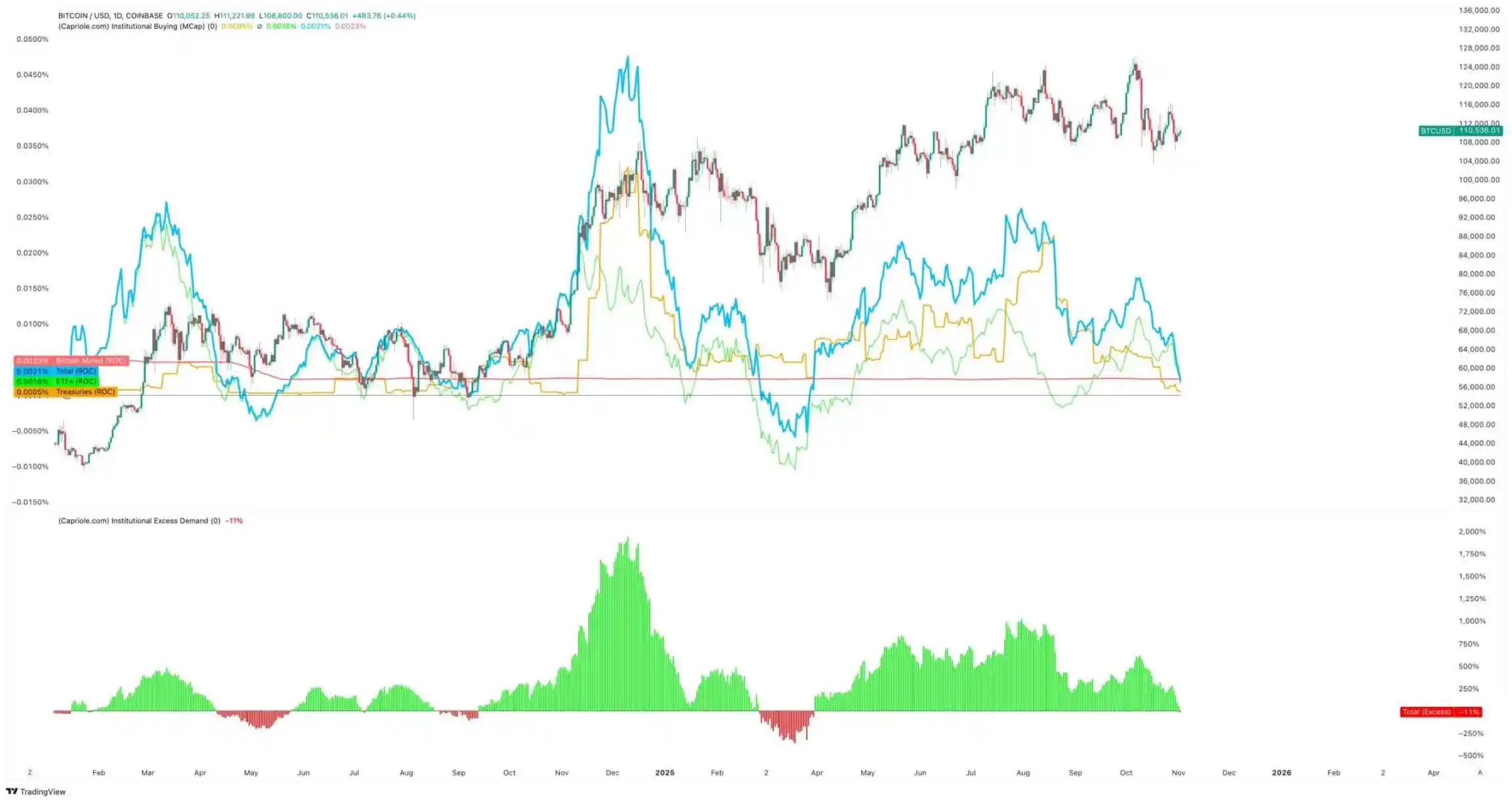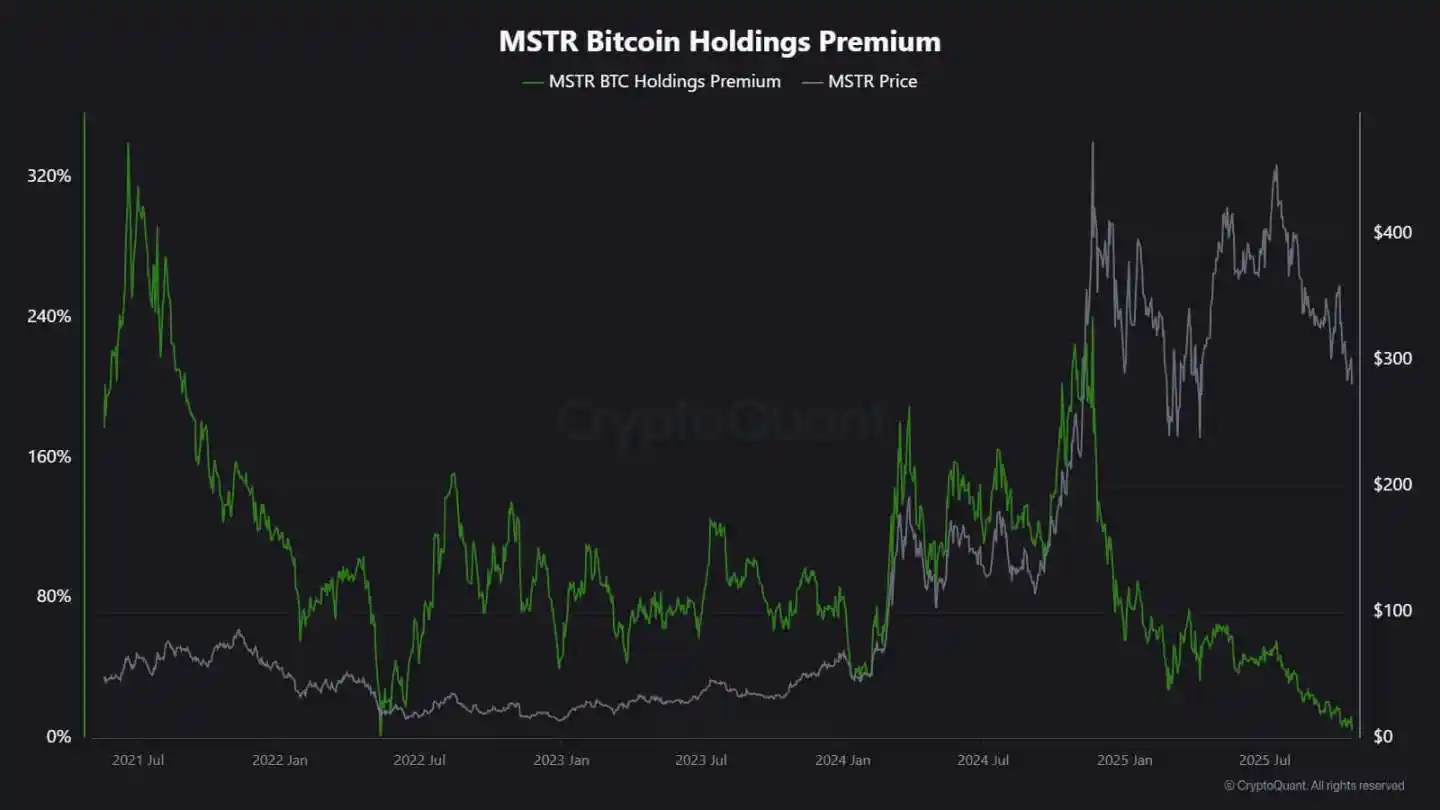Original Title: Why did Bitcoin's largest buyers suddenly stop accumulating?
Original Author: Oluwapelumi Adejumo, Crypto Slate
Original Translation: Luffy, Foresight News
For most of 2025, the support level for Bitcoin seemed unshakeable due to the unexpected alliance between corporate digital asset treasuries (DAT) and exchange-traded funds (ETF), which together formed a solid support base.
Corporations purchased Bitcoin by issuing stocks and convertible bonds, while ETF inflows quietly absorbed the new supply. Together, they built a robust demand foundation that helped Bitcoin withstand the pressures of a tightening financial environment.
Now, this foundation is beginning to loosen.
On November 3, Charles Edwards, founder of Capriole Investments, posted on the X platform that his bullish expectations have weakened as institutional buying has slowed.
He pointed out, "For the first time in 7 months, institutional net buying has fallen below daily mining supply, which is concerning."

Bitcoin institutional buying volume, source: Capriole Investments
Edwards stated that even though other assets are performing better than Bitcoin, this indicator remains a key reason for his optimism.
However, as it stands, about 188 corporate treasuries hold substantial Bitcoin positions, many of which have relatively singular business models aside from their Bitcoin exposure.
Slowdown in Bitcoin Treasury Accumulation
No company better represents corporate Bitcoin trading than MicroStrategy, which recently rebranded itself as "Strategy."
Led by Michael Saylor, this software manufacturer has transformed into a Bitcoin treasury company, currently holding over 674,000 Bitcoins, firmly maintaining its position as the largest single corporate holder globally.
However, its buying pace has significantly slowed in recent months.
In the third quarter, Strategy only added about 43,000 Bitcoins, the lowest quarterly buying volume this year. Considering that the company's Bitcoin purchases during this period dropped to just a few hundred, this figure is not surprising.
CryptoQuant analyst J.A. Maarturn explained that the slowdown in accumulation may be related to the decline in Strategy's net asset value (NAV).
He noted that investors previously paid a high "NAV premium" for every $1 of Bitcoin on Strategy's balance sheet, effectively allowing shareholders to share in the gains from Bitcoin's rise through leveraged exposure. However, since mid-year, this premium has significantly narrowed.
With the valuation premium diminishing, purchasing Bitcoin through new stock issuance no longer yields significant appreciation, leading to a decrease in corporate financing motivation.
Maarturn pointed out: "Financing has become more difficult, and the stock issuance premium has dropped from 208% to 4%."

Strategy stock premium, source: CryptoQuant
Meanwhile, the trend of slowing accumulation is not limited to Strategy.
The Tokyo-listed company Metaplanet had previously emulated this American pioneer’s model, but after a significant drop in its stock price, it is now trading below the market value of its Bitcoin holdings.
In response, the company approved a stock buyback plan while introducing new financing guidelines to expand its Bitcoin treasury. This move indicates the company's confidence in its balance sheet but also highlights the waning enthusiasm among investors for the "crypto treasury" business model.
In fact, the slowdown in Bitcoin treasury accumulation has led to some corporate mergers.
Last month, asset management firm Strive announced the acquisition of the smaller Bitcoin treasury company Semler Scientific. After the merger, these companies will hold nearly 11,000 Bitcoins.
These cases reflect structural constraints rather than a loss of belief. When stock or convertible bond issuances can no longer command a market premium, capital inflows will dry up, and corporate accumulation will naturally slow.
How is ETF Capital Flowing?
Long regarded as an "automatic absorber of new supply," spot Bitcoin ETFs are also showing similar signs of fatigue.
For most of 2025, these financial investment tools dominated net demand, with subscription volumes consistently exceeding redemption volumes, especially during Bitcoin's surge to historical highs.
However, by late October, their capital flows became unstable. Influenced by changes in interest rate expectations, portfolio managers adjusted positions, and risk departments reduced exposure, leading to some weeks of negative capital flow. This volatility marks a new behavioral phase for Bitcoin ETFs.
The macro environment has tightened, hopes for rapid interest rate cuts have gradually faded, and liquidity conditions have cooled. Nevertheless, demand for Bitcoin exposure remains strong, but it has shifted from "steady inflows" to "pulse-like inflows."
Data from SoSoValue visually reflects this transition. In the first two weeks of October, crypto asset investment products attracted nearly $6 billion in inflows; however, by the end of the month, as redemption volumes rose to over $2 billion, some of the inflows were erased.

Bitcoin ETF weekly capital flow, source: SoSoValue
This pattern indicates that Bitcoin ETFs have matured into a true two-way market. They still provide deep liquidity and institutional access channels, but they are no longer one-way accumulation tools.
When macro signals fluctuate, the speed at which ETF investors exit may be just as rapid as their entry.
Market Impact on Bitcoin
This shift does not necessarily mean Bitcoin will face a downturn, but it does indicate that volatility will increase. As the absorption capacity of corporations and ETFs weakens, Bitcoin's price movements will increasingly be driven by short-term traders and macro sentiment.
Edwards believes that in this scenario, new catalysts—such as monetary easing, regulatory clarity, or a return of risk appetite in the stock market—could reignite institutional buying.
However, for now, marginal buyers are more cautious, making price discovery more sensitive to the global liquidity cycle.
The impact is primarily reflected in two aspects:
First, the structural buying that once served as a support level is weakening. During periods of insufficient absorption, intraday volatility may intensify due to a lack of stable buyers to dampen volatility. The halving in April 2024 will mechanically reduce new supply, but without sustained demand, scarcity alone cannot guarantee price increases.
Second, Bitcoin's correlation characteristics are changing. As balance sheet accumulation cools, this asset may once again follow the overall liquidity cycle. Periods of rising real interest rates and a strengthening dollar may exert pressure on prices, while a loose environment could allow it to regain a leading position in risk-on rallies.
Essentially, Bitcoin is re-entering a macro-reflective phase, with its performance resembling that of high beta risk assets rather than digital gold.
Meanwhile, none of this negates Bitcoin's long-term narrative as a scarce, programmable asset. On the contrary, it reflects the increasing influence of institutional dynamics—those institutions that once shielded Bitcoin from retail-driven volatility are now the very mechanisms that have tightened its ties to capital markets.
The coming months will test whether Bitcoin can maintain its value storage properties in the absence of automatic capital inflows from corporations and ETFs.
Historically, Bitcoin has often demonstrated adaptability. When one demand channel slows, another emerges—potentially from national reserves, fintech integration, or a return of retail investors during macro easing cycles.
免责声明:本文章仅代表作者个人观点,不代表本平台的立场和观点。本文章仅供信息分享,不构成对任何人的任何投资建议。用户与作者之间的任何争议,与本平台无关。如网页中刊载的文章或图片涉及侵权,请提供相关的权利证明和身份证明发送邮件到support@aicoin.com,本平台相关工作人员将会进行核查。




